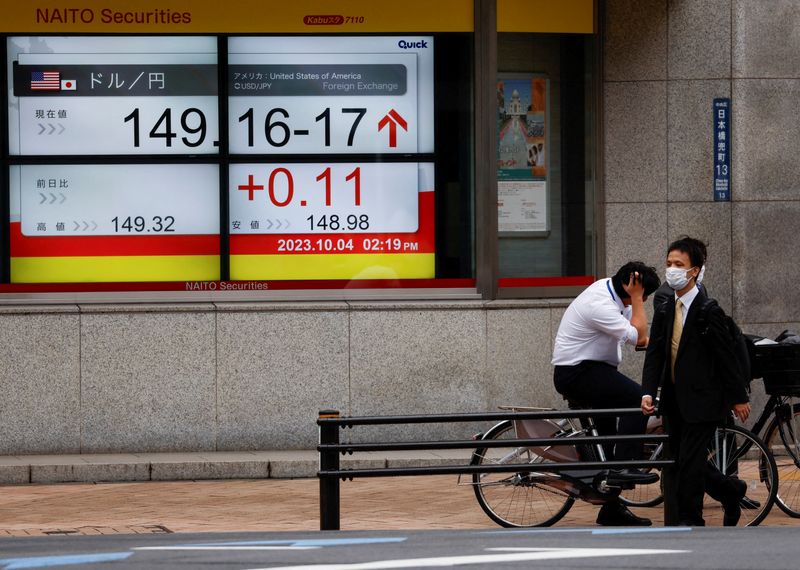By Jamie McGeever
(Reuters) - A look at the day ahead in Asian markets.
Asian stocks are set to open sharply lower on Monday, tracking Wall Street's slump on Friday after investors interpreted U.S. jobs data and comments from top Fed officials as a 'worst of both worlds' outcome - further labor market weakness, but little appetite to cut interest rates by 50 basis points next week.
Japanese futures point to the Nikkei 225 index opening down more than 3%, dragged lower also by the yen's strength, another indication of the risk aversion permeating world markets.
The S&P 500 and the Dow's losses on Friday secured the biggest weekly drop since March 2023, and the Nasdaq's 2.6% fall confirmed its biggest weekly loss since January 2022.
If heightened anxiety over the U.S. economic and policy outlook were not enough, Asia's calendar is packed with top-tier economic indicators from China, Japan and Taiwan that will be of potential global significance too.
Japan releases bank lending, trade, current account and revised GDP growth figures, Taiwan releases trade data, and perhaps most important of all, China unveils producer and consumer price inflation figures.
Overseas investors are growing more cautious on Asian stocks. LSEG data show they were net sellers in August, while JP Morgan recently ditched its buy recommendation on Chinese stocks. Chinese stocks on Friday closed at a seven-month low.
The signals from the United States on Friday were probably more nuanced than markets' negative reaction would suggest. The unemployment rate ticked lower, wage growth accelerated and officials reaffirmed their confidence in a 'soft landing'.
Fed Governor Christopher Waller or New York Fed President John Williams both said on Friday that it is time to cut rates. But in prepared remarks and question and answer sessions, neither signaled that a 50 basis point cut is in the offing.
Oil and commodity prices, meanwhile, are falling rapidly, another sign of investors' growing unease about the global economic picture. Asia's calendar on Monday will deliver another few pieces of that jigsaw.
Figures from Beijing are expected to show that annual consumer inflation in China accelerated to 0.7% in August from 0.5% in July.
That would be welcome progress. But the fight against deflation is nowhere near over - data on Monday are expected to show that factory gate prices fell 1.4% year-on-year in August, nearly twice the pace of July's 0.8% fall.
Former central bank governor Yi Gang on Friday urged the country to do more to fight deflationary pressures with more fiscal stimulus and accommodative monetary policy.
Japan's second quarter GDP growth is expected to be revised up slightly, while Taiwan's export growth is forecast to have more than doubled in August to 7.35%. Taiwan's TSMC is the world's largest contract chipmaker and Nvidia (NASDAQ:NVDA)'s chip manufacturing partner.
Here are key developments that could provide more direction to Asian markets on Monday:
- China PPI, CPI inflation (August)

- Japan GDP (Q2, revised)
- Taiwan trade (August)